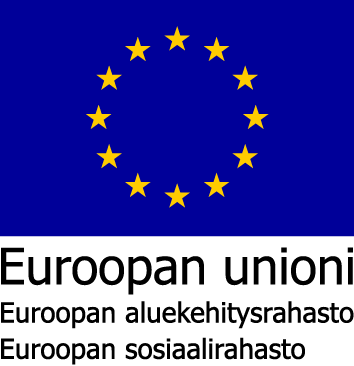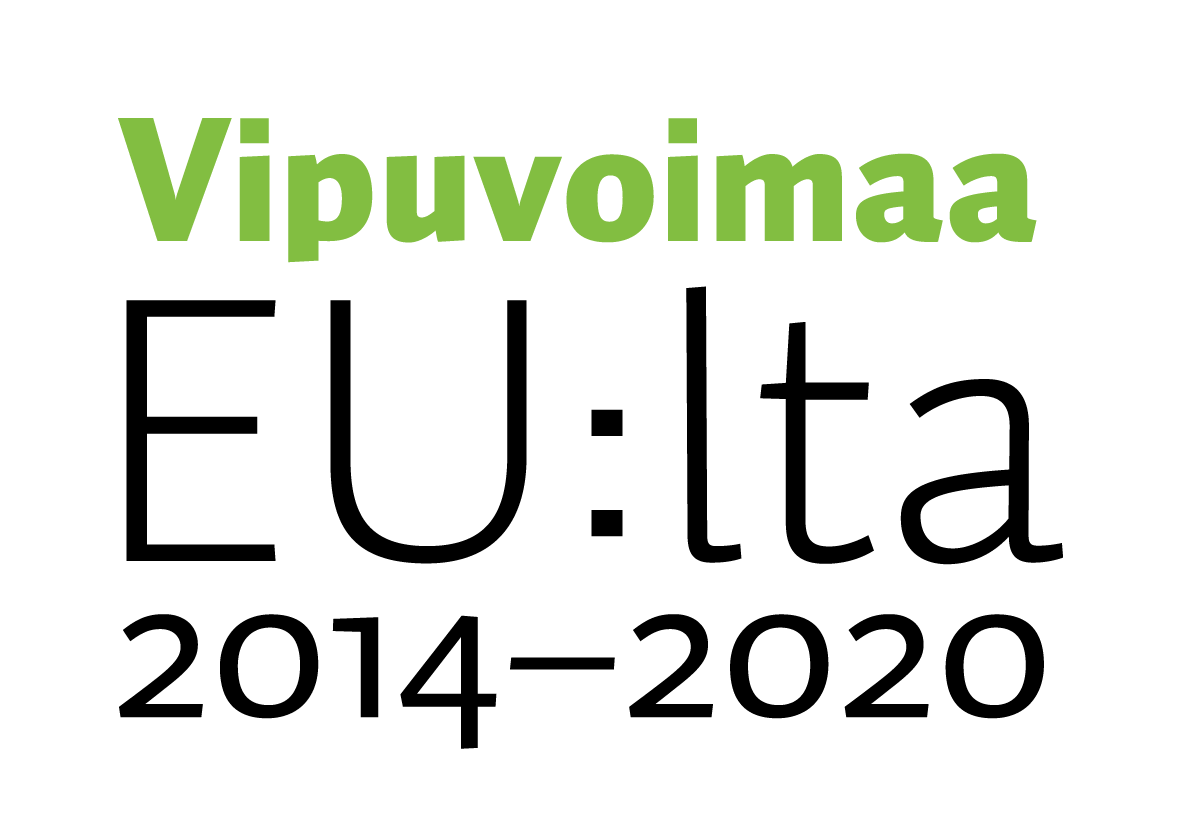

 |
 |
Hankekoodi: S21761
Hankkeen nimi: SATADUUNIA - Työikäisten monialaisen palvelun ja työhönvalmennuksen kehittäminen Satakunnassa
Toimintalinja: 5. Sosiaalinen osallisuus ja köyhyyden torjunta
Erityistavoite: 10.1. Työelämän ulkopuolella olevien työ- ja toimintakyvyn parantaminen
Suunnitelman mukainen toteutusaika: Alkaa 1.8.2019 ja päättyy 31.7.2022
Toiminnan tila: Toiminta päättynyt
Vastuuviranomainen: Keski-Suomen elinkeino-, liikenne- ja ympäristökeskus
Hakijan virallinen nimi: Satakunnan Sairaanhoitopiirin kuntayhtymä
Organisaatiotyyppi: Kuntayhtymä
Y-tunnus: 0825915-6
Jakeluosoite: Sairaalantie 3
Puhelinnumero: 02 627 71
Postinumero: 28500
Postitoimipaikka: Pori
WWW-osoite: http://www.satasairaala.fi
Hankkeen yhteyshenkilön nimi: NIEMI MARI TIINA HELENA
Yhteyshenkilön asema hakijaorganisaatiossa: Hanketoiminnan päällikkö
Yhteyshenkilön sähköpostisoite: mari.niemi(at)satasairaala.fi
Yhteyshenkilön puhelinnumero: 0447077795
Hakijoiden lukumäärä tai tuen siirto -menettely:
Hankkeen päätavoitteena on parantaa työikäisten palveluiden tarve- ja asiakaslähtöisyyttä sekä oikea-aikaisuutta ja sujuvuutta. Palveluja suunnitellessa huomioidaan koko maakunnan työikäinen väestö, eri-ikäiset työssäkäyvät ja työttömät. Kohderyhmänä ovat haasteellisessa työmarkkinatilanteessa olevat, erityisesti nuoret aikuiset sekä vammaiset, kehitysvammaiset tai päihde- ja mielenterveyskuntoutujat. Tavoitteena on luoda maakuntaan monialaiset, varhaisen vaiheen palvelut, joissa työikäiset saavat tarvettaan vastaavia palveluja mahdollisimman oikea-aikaisesti. Varhainen tuki on tärkeää pitkittyvän työttömyyden ennaltaehkäisyssä.
Hankkeen toiminta-alueena on koko Satakunta, sillä tavoitteena on luoda maakunnalliset toimintamallit. Kehittämistyötä tehdään maakunnallisissa verkostoissa ja työryhmissä. Hankkeen pilotointialueena toimivat Porin perusturva ja Euran kunta.
Hankkeen toimenpiteet asemoituvat kolmen toimenpidekokonaisuuden alle, jotka linkittyvät yhteen ja tukevat toinen toisiaan.
I HANKKEEN YLEISET TEHTÄVÄT
Hankkeen yleisiä tehtäviä ovat mm. arviointi, viestintä ja digitaalisten palveluiden kehittäminen.
II TYÖIKÄISTEN MONIALAISEN PALVELUN MALLINNUS HUOMIOIDEN NUORTEN JA TYÖTTÖMIEN PALVELUT SEKÄ TYÖTERVEYSHUOLTO OSANA PALVELUKETJUJA
Toimenpiteissä pohjana on SATAOSAA-kärkihankkeessa (mm. https://virtuaalikirja.fi/sataosaa/) aloitettu mallinnus, jota jatkokehitetään ja pilotoidaan hankkeen aikana.
Hankkeessa mm.
- koulutettujen työkykykoordinaattorien osaamista hyödynnetään eri tehtävissä, ja
- eri toimijoiden tehtävät kootaan yhteisiksi, verkostomaisiksi palveluketjuiksi.
Erityinen paino on
- nuorissa aikuisissa, joilla on haasteita elämänhallinnassa ja työllistymisessä, sekä
- työttömissä työnhakijoissa, jotka tarvitsevat monialaisia palveluja elämäntilanteessaan.
Tavoitteena on parantaa kohderyhmään kuuluvien asiakkaiden työmarkkina-asemaa.
III TYÖHÖNVALMENNUSTIIMITYÖN MALLINTAMINEN JA PILOTOINTI ERITYISESTI VAMMAIS- SEKÄ PÄIHDE- JA MIELENTERVEYSPALVELUISSA
Työhönvalmennusverkosto ja –tiimit ovat osa työikäisten monialaista palvelua. Hankkeessa mm.
- mallinnetaan ja pilotoidaan asiakasta parhaiten palvelevaa sosiaalista kuntoutusta,
- integroidaan kuntoutuminen aitoon työelämään sekä
- parannetaan työhönvalmennuksen saatavuuden ja osaamisen lisäämistä.
Vaikka tavoitteena on geneerinen toimintamalli, pilotoinnin erityisenä kohderyhmänä ovat vammaiset, kehitysvammaiset sekä päihde- ja mielenterveyspalveluiden asiakkaat. Näiden kohderyhmien työllistyminen ja osallisuus vaativat erityistä tukea.
Hankkeen tuotoksena syntyy mm.
- uusia ja jatkotyöstettyjä toimintamalleja,
- erilaisia raportteja ja selvityksiä ja
- koulutuksia ja valmennuksia materiaaleineen.
Hankkeen tuloksena mm.
- Asiakkaiden työllisyys, toimintakyky ja osallisuus kaikissa muodoissaan paranee.
- Palveluketjut sujuvoituvat ja katkoskohdat vähenevät.
- Ammattilaisten osaaminen kasvaa ja verkostomainen yhteistyö lisääntyy.
- Pitkällä aikavälillä myös kustannusvaikuttavuus paranee.
Hankkeen kohderyhmänä ovat heikossa työmarkkina-asemassa olevat, syrjäytyneet työikäiset satakuntalaiset naiset ja miehet. On tutkittu, että miehillä on naisia suurempi vaara syrjäytyä tilanteessa, jossa osallisuuden kokemukset puuttuvat tai elämässä useat riskitekijät ovat toteutuneet (kuten pitkäaikaistyöttömyys, sairaus).
Kohderyhmään kuuluvat voivat olla työttömiä tai osatyökykyisiä eri syistä (mm. fyysiset tai psyykkiset ongelmat, vammaisuus). Kohderyhmän henkilöt tarvitsevat elämänhallintaan erityistä tukea. Erityisenä painopisteenä ovat nuoret aikuiset sekä vammaiset, kehitysvammaiset ja päihde- ja mielenterveyskuntoutujat.
Asiakkaat voivat ohjautua hankkeen toimenpiteisiin eri tahojen (sosiaali- ja terveyspalvelut, TE-palvelut, oppilaitokset, kolmas sektori) kautta. Kokemusasiantuntijat kuuluvat varsinaiseen kohderyhmään silloin, kun he eivät saa hankkeesta palkkaa tai palkkioita. Ne kokemusasiantuntijat, joita käytetään hankkeen toimenpiteissä asiantuntijoina ja joille maksetaan palkkio, eivät kuulu kohderyhmiin.
Lisäksi varsinaisena kohderyhmänä ovat Satakunnan sosiaali- ja terveydenhuollon tai työvoimahallinnon palveluista vastaavat ammattilaiset, jotka työskentelevät em. asiakaskohderyhmien palveluissa. Jokaisen palveluketjussa toimivan ammattilaisen toiminnalla on vaikutusta asiakkaan kuntoutus- ja työllisyyspolun etenemiseen. Ammattilaisten osaamista on lisättävä, jotta yhteisesti sovitut toimintamallit jalkautuvat käytäntöön.
Pilottivaiheessa työnantajina toimivat yritykset ovat myös varsinaista kohderyhmää silloin, kun he osallistuvat hankkeen valmennuksiin ja työntekijän valmennettuun työllistämiseen.
Hankkeen välillisinä kohderyhminä ovat
- Satakunnan kunnat ja veronmaksajat, jotka hyötyvät paremmista palveluista ja sote-kulujen vähenemisestä.
- sote-organisaatioiden päättäjät ja virkamiesjohto. Erityisesti päätöksentekijöiden ja johdon sitouttamisen ja ymmärryksen lisäämisellä kehittämistyö voidaan juurruttaa. Käytännön työntekijät tarvitsevat uuden toiminnan käyttöönotossa vahvaa oman esimiehensä sekä koko organisaatiojohdon tukea ja resursseja.
- yritykset ja muut kuin varsinaisia kuntoutuspalveluja tuottavat kolmannen sektorin toimijat.
Myönnetty EU- ja valtion rahoitus: 450 028
Toteutunut EU- ja valtion rahoitus: 370 929
Suunniteltu julkinen rahoitus yhteensä: 650 547
Toteutunut julkinen rahoitus yhteensä: 563 484
Maakunnat: Satakunta
Seutukunnat: Porin, Rauman
Kunnat: Eura, Ulvila, Pori, Merikarvia
Jakeluosoite:
Postinumero:
Postitoimipaikka:
Suunniteltu: 25
Toteutunut seurantatietojen mukaan: 0
Suunniteltu: 340
| Välitön | Välillinen | |
| Ekologinen kestävyys | ||
| Luonnonvarojen käytön kestävyys | 0 | 0 |
| Vähäinen vaikutus liikkumisen vähenemisen vuoksi (digitaalisten palveluiden myötä) | ||
| Ilmastonmuutoksen aiheuttamien riskien vähentäminen | 0 | 0 |
| Vähäinen vaikutus liikkumisen vähenemisen vuoksi (digitaalisten palveluiden myötä) | ||
| Kasvillisuus, eliöt ja luonnon monimuotoisuus | 0 | 0 |
| Vähäinen vaikutus liikkumisen vähenemisen vuoksi (digitaalisten palveluiden myötä) | ||
| Pinta- ja pohjavedet, maaperä sekä ilma (ja kasvihuonekaasujen väheneminen) | 0 | 0 |
| Vähäinen vaikutus liikkumisen vähenemisen vuoksi (digitaalisten palveluiden myötä) | ||
| Natura 2000 -ohjelman kohteet | 0 | 0 |
| Vähäinen vaikutus liikkumisen vähenemisen vuoksi (digitaalisten palveluiden myötä) | ||
| Taloudellinen kestävyys | ||
| Materiaalit ja jätteet | 0 | 0 |
| Vähäinen vaikutus liikkumisen vähenemisen vuoksi (digitaalisten palveluiden myötä) | ||
| Uusiutuvien energialähteiden käyttö | 0 | 0 |
| Vähäinen vaikutus liikkumisen vähenemisen vuoksi (digitaalisten palveluiden myötä) | ||
| Paikallisen elinkeinorakenteen kestävä kehittäminen | 3 | 4 |
| Hankkeen tavoitteena on lisätä haasteellisessa työmarkkina-asemassa olevien osallisuutta ja työllisyyttä. Henkilön kuntoutuminen ja siirtyminen esim. koulutukseen tai työelämään tuo kustannussäästöä. Tämä vaikuttaa suoraan esim. työnantajien kustannuksiin positiivisesti. Välillisenä tavoitteena on vaikuttaa myönteisesti myös yritysten työvoiman saatavuuteen. | ||
| Aineettomien tuotteiden ja palvelujen kehittäminen | 5 | 5 |
| Hankkeen tavoitteena on aineettomien palveluiden kehittäminen, ja vaikutusten oletetaan olevan sekä suorat että välilliset. | ||
| Liikkuminen ja logistiikka | 1 | 1 |
| Vähäinen vaikutus liikkumisen vähenemisen vuoksi (digitaalisten palveluiden myötä) | ||
| Sosiaalinen ja kulttuurinen kestävyys sekä yhdenvertaisuus | ||
| Hyvinvoinnin edistäminen | 10 | 10 |
| Hankkeen tavoitteena on asiakkaan, elämänlaadun, hyvinvoinnin ja toimintakyvyn parantaminen. Asiakkaan osallisuuden (tieto-, suunnittelu-, toiminta- ja päätöksenteko-osallisuus) huomioiminen edistää hänen voimaantumistaan. Tämä vaikuttaa myös asiakkaiden lähipiiriin positiivisesti. Hanke muuttaa toimintakulttuuria asiakaslähtöisemmäksi. Muutos tuottaa aikaa myöten positiivisia vaikutuksia. Palveluketjut ovat sujuvia sekä ammattilaisten että asiakkaiden näkökulmasta, päällekkäinen työ vähenee. Asiakastyytyväisyys paranee, mikä vaikuttaa positiivisesti myös ammattilaisten työhyvinvointiin. | ||
| Tasa-arvon edistäminen | 7 | 7 |
| Hanke edistää asiakkaiden yhdenvertaista palveluiden saatavuutta. Lisäksi saavutettavuus paranee (mm. digitaaliset, jopa 24/7, palvelut). Palveluiden laatu ja sisältö määritellään yhdenmukaisesti laadittavissa prosessikuvuaksissa, jolloin paikkakunta- tai toimijakohtainen laadunvaihtelu vähenee. Asiakkaan osallisuuden uudet toimintamallit tukevat tasa-arvon tavoitetta. Asiakkaat ovat myös tasa-vertaisia toimijoita ammattilaisten kanssa. | ||
| Yhteiskunnallinen ja kulttuurinen yhdenvertaisuus | 8 | 8 |
| Hanke edistää asiakkaiden yhdenvertaista palveluiden saatavuutta. Lisäksi saavutettavuus paranee (mm. digitaaliset, jopa 24/7, palvelut). Palveluiden laatu ja sisältö määritellään yhdenmukaisesti laadittavissa prosessikuvuaksissa, jolloin paikkakunta- tai toimijakohtainen laadunvaihtelu vähenee. Asiakkaan osallisuuden uudet toimintamallit tukevat tasa-arvon tavoitetta. Asiakkaat ovat myös tasa-vertaisia toimijoita ammattilaisten kanssa (asiakas oman prosessinsa omistaja). Hankkeen tavoitteena on edistää asiakaskohderyhmien työllisyyttä. Työllistyminen palkkatyöhön lisää yhteiskunnallista yhdenvertaisuutta ja osallisuuden kokemusta. | ||
| Kulttuuriympäristö | 0 | 0 |
| Hanke on neutraali tämä tavoitteen osalta. | ||
| Ympäristöosaaminen | 0 | 0 |
| Vähäinen vaikutus liikkumisen vähenemisen vuoksi (digitaalisten palveluiden myötä) | ||
SATADUUNIA-hankkeen päätavoitteena oli parantaa heikossa työmarkkina-asemassa olevien työikäisten satakuntalaisten työllistymisen ja työkyvyn tuen palveluja. Tavoitteena oli siirtää palveluiden painopistettä varhaisempaan ja ennaltaehkäisevään vaiheeseen, sekä lisätä ja edistää osallisuutta sen kaikissa muodoissa. Tavoitteena oli kehittää toimintaa niin, että eri toimijat tietävät roolinsa ja vastuunsa työikäisten sote-palveluiden työllistymisprosessissa ja toimijoiden välinen yhteistyö tiivistyy. Ammattilaisten osaamisen lisääminen ja digitaalisten palveluiden kehittäminen palvelujen saatavuuden parantamiseksi olivat myös hankkeen tavoitteita.
Tavoitteiden saavuttamiseksi hankkeessa tuotettiin paljon erilaisia nykytilakuvauksia, selvityksiä ja raportteja, joiden kautta saatua tietoa käytettiin mm. pilottityöskentelyn pohjana. Hankkeen aikana toteutettiin useita pilotteja, joiden kautta saatiin tärkeää kokemusta ja tietoa siitä, miten työikäisten työkyvyn tuen palveluita kannattaisi Satakunnassa kehittää. Hankkeen tuloksena muodostui käsitys siitä, mitä ovat sote-palvelut, joihin liittyy työ- ja toimintakyvyn arviointi ja tuki, sekä yhteistyötarve työ- ja toimintakykyyn liittyvissä asioissa.
Nykytilatiedon ja piloteista saadun kokemuksen pohjalta hankkeessa on vahvistettu ammattilaisten osaamista erityisesti työ- ja toimintakykyyn ja kuntoutukseen liittyvissä asioissa, sekä lisätty ratkaisukeskeistä työotetta. Lisäksi on vahvistettu monialaista verkostoyhteistyötä luomalla uusia toimintamalleja, joiden avulla heikossa työmarkkinatilanteessa olevien satakuntalaisten työllistymiskykyä, toimintakykyä ja osallisuutta voidaan tukea. Tämän avulla on vaikutettu myös asiakkaan työkykyyn liittyvien ongelmien aiempaa parempaan tunnistamiseen.
SATADUUNIA-hankkeella on ollut vahva yhteys sekä Työkykyohjelmaan kuuluvan Työkykyä Satakuntaan-hankkeeseen (STM), että Satakunnan Tulevaisuuden sosiaali- ja terveyskeskus –ohjelman hankkeeseen (STM). SATADUUNIA-hankkeen tuottamaa tietoa ja toimintamalleja voidaan suoraan hyödyntää kehitettäessä Satakuntaan toimiva työikäisten työkyvyn tuen palvelukokonaisuus tulevaisuuden sote-keskukseen. SATADUUNIA-hankkeessa kertynyttä tietoa voidaan käyttää myös johtamisen ja päätöksenteon tukena, kun hyvinvointialueella määritellään työkyvyn tuen palveluiden tavoitteet.
Hankkeen järjestämissä koulutuksissa on lisätty ja vahvistettu ammattilaisten osaamista mm. ammatillisesta kuntoutuksesta, työttömien terveydenhuollosta, työ- ja toimintakyvyn arvioinnista, monialaisesta yhteistyöstä työllistymisprosessissa, TE-toimiston ja Kelan palveluista, työhönvalmennuksesta ja ratkaisukeskeisestä työotteesta. Asiakkaille toteutettiin koulutuksia, jotka tukivat ja paransivat heidän elämänhallintaa ja mielenterveyttä, sekä vahvistivat sitä kautta heidän työllistymismahdollisuuksiaan ja työelämään pääsyä.
Hankkeen tuloksena syntyi uusia- ja jatkokehitettyjä toimintamalleja, mm. Walk in-, RAPIAT-, Saattaen-vaihtaen, työkykytiimien-, sekä ryhmämuotoisen työhönvalmennuksen toimintamallit. Toimintamalleissa oleellista oli kehittää ammattilaisten yhteistyötä yli organisaatiorajojen ja luoda uudenlaista toimintatapaa monialaiseen työhön. Työ- ja toimintakyvyn, sekä työllistymisen tuki ja asiakkaan osallisuus olivat kaikissa toimintamalleissa vahvasti läsnä.
Hankkeessa jatkokehitettiin mm. Satasairaalan kuntoutuspoliklinikalla käytössä ollutta Walk in –toimintamallia, jossa asiakas pääsee nopeasti ja matalalla kynnyksellä ilman lääkärin lähetettä kuntoutussuunnittelijan kartoittavalle vastaanottokäynnille. Asiakkaan palvelutarve tunnistetaan TE-toimistossa ja virkailija ohjaa asiakkaan sovitun prosessin mukaan kuntoutussuunnittelijalle erikoissairaanhoitoon.
RAPIAT–toimintamallissa kuvattiin opiskelijan tuen tarpeen ja jatkopolun selvittelyä yhteistyössä RAPIAT–ryhmän (rajapinta-asiakkaat) kanssa. Toimintamallissa yhteistyötä tekivät ammattioppilaitos, sekä Porin perusturvan vammaispalvelut ja psykososiaaliset palvelut erityistä tukea tarvitsevien opiskelijoiden tukemisessa opintojen aikana.
Saattaen-vaihtaen –toimintamallissa varmistettiin työkyvyn kannalta oleellisen tiedon siirtyminen asiakkaan mukana, kun asiakas jäi työttömäksi terveydellisten syiden vuoksi. Asiakkaalle pyrittiin turvaamaan hänelle soveltuvat palvelut heti työttömyyden alkuvaiheessa, niin perusterveydenhuollossa, kuin TE-toimistossakin. Asiakkaat olivat myös itse vahvasti mukana prosessissa.
Työkykytiimin –toimintamallissa olennaista oli ammattilaisten antama pitkäaikainen tuki ja asiakkaan palveluiden etenemisen varmistaminen koordinoidusti. Toimintaa suunniteltiin moniammatillisessa yhteistyössä, sitä arvioitiin ja asiakas sai riittävän intensiivisen, pitkäaikaisen ja yksilöllinen tuen.
Ryhmämuotoisen työhönvalmennuksen toimintamallin avulla voitiin mahdollistaa osatyökykyisten pääsyä tutustumaan työelämään ja työyhteisöön yhteiskunnan jäsenenä. Malli soveltui hyvin kaikkein heikoimmassa työmarkkina-asemassa olevien henkilöiden (kehitysvammaiset) osallisuuden edistämiseen ja vahvistamiseen, elämänhallinnan parantamiseen ja arjenhallinnan tukemiseen.
Euran kehittäjäryhmässä kehitettiin kehitysvammaisten avotyötoiminnan asiakkaiden palveluja yhteistyössä asiakkaiden, esihenkilöiden, päättäjien ja ammattilaisten kanssa. Yhteiskehittämisen avulla tuotiin avotyötoiminnan asiakkaiden kokemustieto osaksi palveluiden kehittämistä. Huittisten yhteiskehittäjäryhmässä kehitettiin kehitysvammaisten polkua avotyöstä kohti palkkatyötä moniammatillisesti.
Digitaalisten palvelujen käyttöä palvelujen saatavuuden parantamiseksi aloitettiin hankkeen aikana kehittämällä Walk in –toimintamallia digitaaliseen suuntaan yhteistyössä toimijoiden kanssa. Kehitystyö saatiin alkuun ja sen kehittäminen jatkuu syksyllä Työkykyä Satakuntaan –hankkeen toimesta.